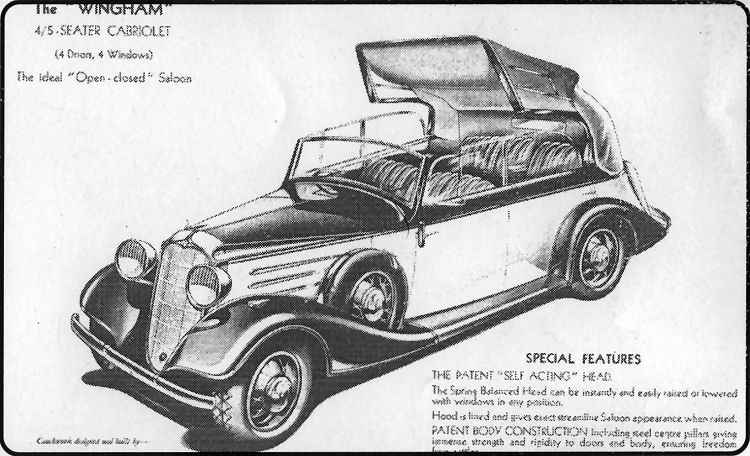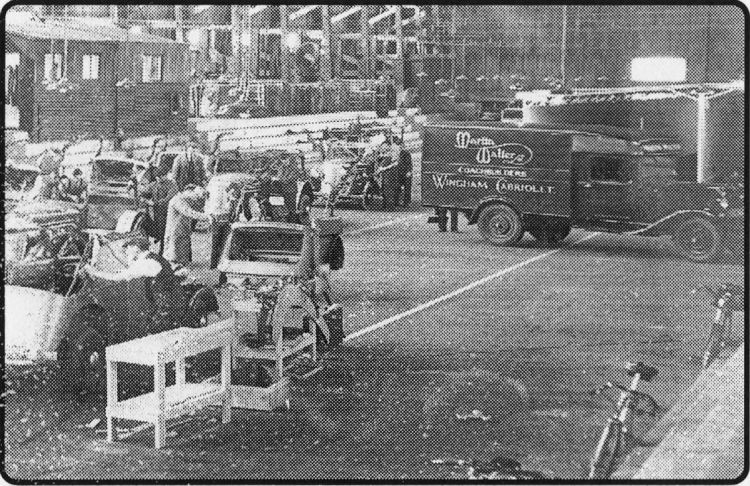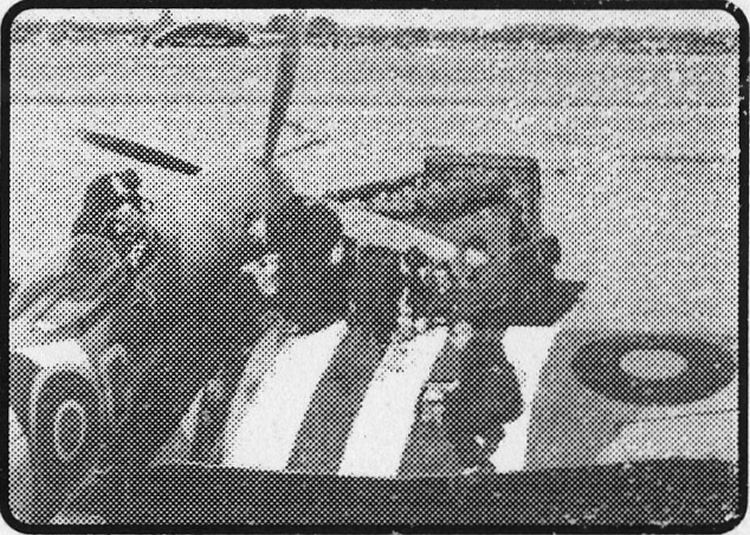
From the Folkestone Herald Published 1 June 2000
Local ‘special’
CAR ENTHUSIAST David Peters writes to the Herald from Macaulay Drive,
Aberdeen, for help in a restoration job he is about to begin on a 1936
Daimler car with ‘Wingham’ coachwork body by Martin Walter, of Folkestone.
“The car is in a sorry state but is ripe for restoration,” he writes.
''Apparently Martin Walter built his Wingham body style on a number of
manufacturers' chassis, Including Daimler, Lanchester, Hillman, Talbot and
Vauxhall,” he goes on.
“But very little archive information
exists from Martin Walter as the company was bought over in 1937 by Abbey
Coachbuilders (? Bob's query) and later subsumed Into the Dormobile
Company,” he had been informed, he writes.
“My reason for writing to you is to ask if any of your readers can assist
with photographs or indeed any Information on the Wingham body details which
may assist in the vehicle's restoration. Thanking you in hope, - David
Peters, ‘Flinders’ 30 Macaulay Drive, Aberdeen, AB15 8FL”
Mr Peters Tel/fax number is 01224 317770 or he can be contacted on e-mail
djpeters@talk21.com
Well, thanks to Memories reader Dennis Pullen, who lives
at Broadmead Village, Folkestone, and worked for Martin Walter around 17
years and contacted me over a year ago about Martin Walter cars, I can
supply David with some of the information he seeks.
Dennis allowed me to copy some of his collection of photographs and artists’
Impressions of former Martin Walter cars. These include an artist's
Impression of a Vauxhall with Wingham coachwork and also a photo of the
former airship shed at Capel where Martin Walters set up a mini-production
line to build the Wingham bodies on different chassis.

SMART Wingham cabriolet body design by craftsmen of Martin Walters of
Folkestone who used to be one of the town’s major employers. The artist’s
impression was shown to me by Memories reader Dennis Pullen, of Folkestone.
My own researches for Memories articles as long ago as 1998 show that Capel
airship shed, built at a cost of over £35,000 during the First World War to
house blimps, as the airships were sometimes called, was being taken over In
March 1935 by Martin Walter who needed more space to cope with demand for
its coachwork.
Martin Walter MD Mr Spencer Apps then told the Herald:
“We have negotiated with the East Kent Road Car Company, the owners, to take
over the air shed at Capel owing to the fact that we are so extremely busy,
especially with our Wingham Cabriolet body, at our Cheriton Road factory
that we are unable to deal with the ever-increasing order position.

SCENE inside the former Capel airship hangar of the First World War which
was taken over to build the Martin Walter Wingham cabriolet bodied cars,
particularly Vauxhalls.
“We are re-organising and this additional building will give us a total
floor area of 32,000 sq ft.” Component parts would continue to be made at
Cheriton Road, he said, and the assembly and panelling would be done at
Capel where there would also be the latest cellulose spray-painting booths.
The target would be 150 bodies a month.
Over 300 men were employed at Cheriton Road and the new development at Capel
and on the Cheriton Road site would mean even more jobs.
The Herald reported the Wingham Cabriolet being supplied to motorists all
over the world was designed by Martin Walters. The model enabled a driver to
change from a saloon car to a tourer at a touch of a lever.
Martin Walter, embarking on a big
advertising campaign, said it hoped to produce more than 3,000 Wingham
cabriolet bodied Vauxhalls alone in the coming year. In addition the
same model was included in the catalogues of the Daimler and Lanchester
companies.
Orders came from at least 20 countries and sales could bring fame to
Wingham, after which it was named, and Martin Walter. But the history of
the firm as described to David Peters is not accurate.
“Folkestone Past & Present" is the title of another photogiaphic display to
be given by Folkestone & District Local History Society over several months
from June 5 to August 31. An enterprising group, the society is opening
daily from 10am to 1pm.

A Mustang fighter in D-Day markings at Newchurch from Mustang Wing a new
book about RAF Brenzett, an advanced landing strip, by Anthony John Moor, I
will be writing about shortly in Memories.
 |
|
1900
£50 a year Head sought for Harvey Grammar.
HARVEY Grammar School was advertislng for a new headmaster at
a fixed salary of £50 a year, with a capitation fee of £2 a year per boy
(currently 80 to 90) and rent free house. Boarders at the school were to
be limited to six. Folkestone Express reported on the first motor race
In the USA. It was over a distance of 50 miles and the winning car,
electric powered, finished at an average speed under 25mph! There was
talk of the driver coming over to Europe to race but the writer observed
that he would have to find a much faster carl Second placed was a steam
car, third place going to a petrol engined car. Collections were made in
the streets for a comforts fund for the newly returned wounded soldiers
from South Africa. A trade exhibition at the Town Hall featured a
promenade concert and a mixture of films, latest war photographs and
‘dissolving* pictures. Local newspapers reported that Sipido, a youth of
16 who was arrested after the attempted assassination of the Prince of
Wales in Brussels, said he did it because the Prince had caused
thousands of men to be slaughtered in the Boer War. A bullet passed
within a foot of the Prince’s head.
|
|
1925
Noisy buses spoil holiday trips to town - complaint.
A DULWICH visitor, after returning home wrote to the
paper calling for ‘‘all noisy and clumsy” buses operating a local
service be taken off the road and only those with “silent engines and
proper tyres" be allowed. The vibration at present, he wrote, made it
impossible to sleep in the front bedrooms of guest houses. A Hythe
councillor was negotiating a common timetable and agreement of the majority of operators was expected to cover the 1,202 daily runs between
Folkestone and Hythe. Our man Felix was having a go about the Leas and
reminding the Council that when it took over from the Lord of the Manor,
the care of the Leas and Undercliff it was expected one of the first
steps would be the removal of the unsightly “sheep pens” or iron
railings that enclosed a greater portion of the lawns. A visitor he had
been showing around, he said, thought the railings signified a cattle
market! He called for action by the following summer. Six interesting
old pictures of Tontine Street were splashed on the front page of the
Herald in a full page advertisement of Tontine Street traders holding a
84ay shopping festival. Some of the "100 shops offering unbeatable
values” also filled page 2 with more advertisements. Sadly none of those
pictures are in the Herald's possession today.
|
|
1950
Caravan site scheme for old Capel airship site.
THERE was considerable controversy over plans to create a
caravan site on the old First World War Capel Air Ship Station with its
massive hangar in which the old ‘blimps’ were kept when the airman
conducted submarine-spotting operations from the base. Parish and Rural
Council were against the plan but at a public meeting there was
overwhelming public support for the camp. Major council concern was over
road safety. 82 voted in favour and 32 against. It seemed to be thought
the plans for the site would turn It into a beauty spot. A fine early
picture of Sandgate Road, looking towards the Town Hail, with one of the
town’s earliest motor coaches parked at the side of the road and dwarfed
by a horse-drawn bus, featured in the Herald’s midweek paper the
Folkestone and Hythe Gazette. Regrettably it is not a picture currently
in the possession of the paper otherwise I would feature It in Memories,
such Is the Interest today In early motor vehicles. 10,000 hardy West
Street Hunt followers turned out In freak weather to see small fields
take part in the first post war point-to-point meeting at Aldington. The
Herald's midweek Gazette featured a picture of a replica of an early
Bleriot-type aircraft which once gave demonstration flights from Radnor
Park.
|
|
1975
Gunner recalls shooting down a Zeppelin bomber.
A ROW erupted in the council chamber when Labour
councillors heard their Tory colleagues had decided in secret who should
be chairmen of committees, instead of leaving it to individual
committees to decide. A Burmash farmer caused a row when he decided to
grub a thick hawthorn hedge to excavate a drainage ditch on a parish
boundary. Too many hedges, which provided valuable shelter, were being
last, complained villagers who warned It could become a bleak area
without them. But another farmer changed his mind about grubbing a
similar dyke-side hedge decided to trim it instead. Construction delays
meant that Hythe area schools had to cancel summer term swimming plans
using the town’s new pool. There were some red faces at Dymchurch over
missing signs at the public loos. Easily visible new signs were
certainly a question of convenience! Herald writer Stroller featured the
story of ex-Gunner Fred Dunn, 84, of Folkestone, who re-visited the
Dover heights where he was one of the gun crew who shot down the first
Zeppelin bomber airship In Britain In 1915. Six searchlights, he
recalled, swept the sky and picked up the German raider. “She looked
just like a giant cigar.” His battery's six-pounder Hotchkiss guns fired
“shells which had luminous bases and looked just like cricket balls as
they soared into the air. We cheered when we saw the Zeppelin's nose
turn down,” he said.
|
|




